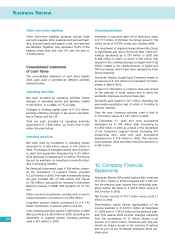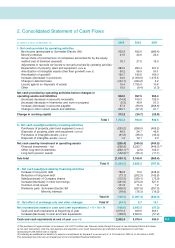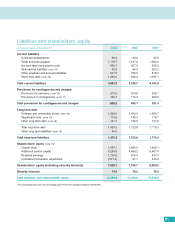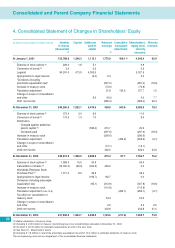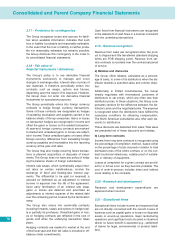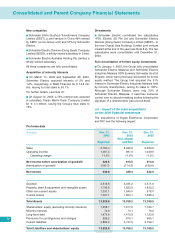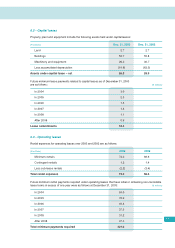APC 2003 Annual Report Download - page 72
Download and view the complete annual report
Please find page 72 of the 2003 APC annual report below. You can navigate through the pages in the report by either clicking on the pages listed below, or by using the keyword search tool below to find specific information within the annual report.
2.17 - Provisions for contingencies
The Group recognizes losses and accrues for liabili-
ties when available information indicates that such
loss or liability is probable and reasonably estimable.
In the event that the loss or liability is neither proba-
ble nor reasonably estimable but remains possible,
the Group discloses this contingency in the notes to
its consolidated financial statements.
2.18 - Fair value of
financial instruments / derivatives
The Group’s policy is to use derivative financial
instruments exclusively to manage and cover
changes in exchange rates, interest rates or prices of
raw materials. It therefore periodically enters into
contracts such as swaps, options and futures,
depending upon the nature of its exposure. However,
the Group does not enter into derivative financial
instruments for speculative purposes.
The Group periodically enters into foreign currency
contracts to hedge foreign currency transactions.
Some of these contracts are designated as hedges
of operating receivables and payables carried in the
balance sheets of Group companies. Gains or losses
on transaction hedges are recognized in income and
offset the gains or losses on the related transaction.
At year-end, foreign currency contracts are marked-
to-market and unrealized gains or losses are reflect-
ed in income. These unrealized gains or losses offset
foreign currency differences from translating foreign
currency payables and receivables into the reporting
currency at the year-end rates.
The Group may also hedge recurring future transac-
tions or planned acquisitions or disposals of invest-
ments. The Group does not have any policy of hedg-
ing the balance sheets of foreign subsidiaries.
Interest rate swaps, which synthetically adjust inter-
est rates on certain indebtedness, involve the
exchange of fixed and floating-rate interest pay-
ments. The differential to be paid (or received) is
accrued (or deferred) as an adjustment to interest
income or expense over the life of the agreement.
Upon early termination of an interest rate swap,
gains or losses are deferred and amortized as
adjustments to interest expense of the related debt
over the remaining period covered by the termination
swap.
The Group also enters into commodity contracts
including forwards, swaps and options to hedge total-
ly or partially its purchases. Unrealized gains or loss-
es on hedging contracts are reflected in the cost of
goods sold when the underlying transaction takes
place.
Hedging contracts are marked to market at the end
of the fiscal year and their fair value is included in off-
balance sheet commitments.
Cash flows from financial instruments are recognized
in the statement of cash flows in a manner consistent
with the underlying transactions.
2.19 - Revenue recognition
Revenue from sales are recognized when the prod-
uct is shipped and title transferred (standard shipping
terms are FOB shipping point). Revenue from ser-
vice contracts is recorded over the contractual period
of service.
a) Rebates and discounts
The Group offers rebates, calculated as a percent-
age of sales, to some of its distributors when the dis-
tributor reaches a specified sales and volume objec-
tive.
Additionally, in limited circumstances, the Group
directly negotiates with international customers of
distributors to set prices, which are often less than
distributor prices. In these situations, the Group com-
pensates vendors for the difference between the dis-
tributor’s price and the negotiated price.The expense
is recognized when the distributors have fulfilled the
necessary conditions for obtaining compensation.
The North American subsidiaries also offer cash dis-
counts to distributors.
These discounts are deducted from sales.Total sales
are presented net of these discounts and rebates.
b) Long-term contracts
Income from long-term contracts is recognized using
the percentage-of-completion method, based either
on the percentage of costs incurred in relation to total
estimated costs of the entire contract, or on the con-
tract’s technical milestones, notably proof of installa-
tion or delivery of equipment..
Losses at completion for a given contract are provid-
ed for in full as soon as they become probable. The
cost of work-in-process includes direct and indirect
costs relating to the contracts.
2.20 - Research and development
Research and development expenditures are
expensed when incurred.
2.21 - Exceptional items
Exceptional items include income and expenses that
are not directly connected with the current course of
business such as capital gains or losses on disposed
assets or wound-up operations, major restructuring
operations and significant costs incurred in situations
where no future benefit is expected (e.g., settlement
of claims for legal, environmental or product liabili-
ties).
Consolidated and Parent Company Financial Statements
70


